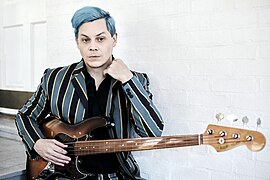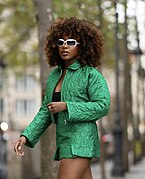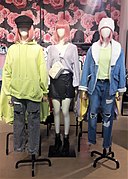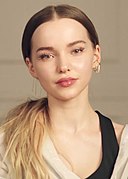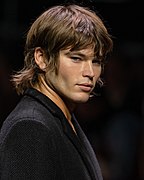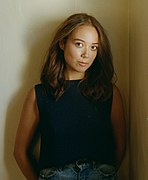
A | B | C | D | E | F | G | H | CH | I | J | K | L | M | N | O | P | Q | R | S | T | U | V | W | X | Y | Z | 0 | 1 | 2 | 3 | 4 | 5 | 6 | 7 | 8 | 9
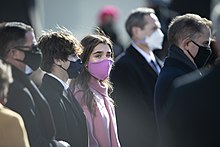
The fashions of the 2020s represent a departure from 2010s fashion and feature a nostalgia for older aesthetics.[1] They have been largely inspired by styles of the late 1990s to mid-2000s, 1980s, and late 1960s to early 1970s.[2][3][4][5][6] Early in the decade, several publications noted the shortened trend and nostalgia cycle in 2020s fashion.[7][8][9][10][11] Fashion was also shaped by the COVID-19 pandemic, which had a major impact on the fashion industry, and led to shifting retail and consumer trends.
In the 2020s, many companies, including current fast fashion giants such as Shein and Temu, have been using social media platforms such as TikTok and Instagram as a marketing tool.[12] Marketing strategies involving third parties, particularly influencers and celebrities, have become prominent tactics. E-commerce platforms which promote small businesses,[13] such as Depop and Etsy, grew by offering vintage, homemade, or resold clothing from individual sellers. Thrifting has also exploded in popularity due to it being centered around finding valuable pieces of clothing at a reasonable price.[14]
General trends
COVID-19 pandemic

During the COVID-19 pandemic, wearing a face mask became a common and often mandatory practice.[15] The mask shortage, the desire for self-expression, and the ability to quickly make masks without specialized technology soon led to a multitude of mask designs.[16][17]
Fashion that prioritized comfort, style, and safety also became more popular during the pandemic, including sneakers, loungewear, athleisure, pajamas, and "Zoom tops", shirts kept close to a wearer to be put on for a video meeting.[18]
Athleisure and activewear
In the United States, athletic wear such as unisex yoga pants, hoodies, athletic shorts,[19][20] Crocs, sneakers, and sweatpants were staples in millennial and Gen Z wardrobes, although these were generally less form-fitting than the athletic wear fashionable in the 2010s. Despite the return to maximalism in certain fashion circles, the vast majority of Americans were still choosing comfortable clothing. This preference for comfortable and affordable clothing can be attributed to the growing emphasis on casual and relaxed styles in everyday life.[21] Additionally, the ongoing athleisure trend reflects a shift towards prioritizing functionality and versatility in fashion choices.[22][23] Some people might blame the COVID-19 pandemic for the prevalence of casual clothing, but some market research indicates that athleisure never really went out of style.[24][25] In fact, athleisure has been gaining popularity for years due to its ability to seamlessly transition from the gym to everyday activities.[26] This trend is further reinforced by the increasing focus on health and wellness, as people seek clothing that allows them to stay active and comfortable throughout the day.[27][28][29][30][31]
Maximalism and 2010s backlash
As the decade started, maximalist fashion made a resurgence on the runway, as a backlash against the fashions of the 2010s. After two years indoors, many younger people started to channel their restless energy into cheery, upbeat fashions.[32] Gen Z fashion enthusiasts found themselves dissatisfied with minimalism and millennial fashion, considering it to be lacking in self-expression and gender neutral representation.[33] All facets of popular culture were briefly impacted by the resurgence in maximalism, especially fashion, interior design, music, and the arts.[34][35][36][37] Although maximalism had made a comeback in online fashion communities, minimalism remained the standard for interior decorating and mainstream fashion . The TikTok algorithm repurposed minimalism as a selection of curated aesthetics and "fashion essentials" that appeal to Gen Z youth.[38][39]
Although they were a fashion must-have in the 2010s, skinny jeans faced a brief backlash at the start of the decade.[40] Many Gen-Z social media influencers on TikTok said that skinny jeans were no longer a symbol of youth culture, causing controversy among fashion bloggers and millennial women.[41][42][43] Separating one's hair to the side (side-part) was also considered to be out of style by Gen-Z influencers.[44][45] The term cheugy was coined to describe "tacky millennial fashion."[46][47]
Internet aesthetics, micro-trends and anti-fashion
The acceleration of new fashion trends and micro-trends, made possible by social media platforms such as Tumblr, Pinterest, Instagram and TikTok, led to shorter trend cycles and faster manufacturing processes by global clothing producers (fast fashion). The pollution linked with fast fashion led to the birth of anti-fashion micro-trends.[48][49] The trend cycle was moving so fast that there were niche revivals for 2010s fashion and 2014 Tumblr.[50][51][52][53][54]
Women's clothing
Early 2020s (2020–2022)
Late 1990s–2000s revival
As the decade began, fashions of the late 1990s and early to mid-2000s (sometimes referred to as 'Y2K fashion'[55]) were a major influence. This contrasted with the fashions of the previous decade which took inspiration from early to mid 90s fashion. On social networks, many influencers constantly look for vintage styles to break from the dominance of massively advertised looks (that they sometimes heavily criticize), a classic nostalgia effect used in the fashion industry.[56] The early 2020s saw renditions of the underwear-as-outerwear and explicit sexuality. Versace, Gucci and Prada made significant returns to latex-inspired styles. Pornhub sponsored an osé fashion collection in Paris. Brands became in demand of a very wide diversity of models (breakthrough of indigenous models). The covid crisis had an impact on fashion continuity, which Vogue described as "chaotic, creative mix of idiosyncratic takes on what the post-pandemic world wants right now". Ghesquière explored vampire looks for Louis Vuitton. [57]
From 2020 to 2022, desirable colours in the US and Europe included navy blue, neon green, electric blue, purple, white, coral, baby pink,[58][59] light grey, silver,[60] pastel pink, violet, pale blue, lavender, mint green,[61] faded yellow, pastel teal, lemon yellow, orange, red, and brown.[62][63]
Popular shirts, coats, and dresses from this time included puffer jackets made from upcycled deadstock fabric, sweatshirts, high waisted pants, tucked-in sweaters, camisoles and crop tops, lowrise miniskirts,[64] brocade topcoats,[61] midriff-baring tops, ribbed turtlenecks, garish Ed Hardy style T-shirts with rhinestones,[58] off-the-shoulder knitted tops, science fiction-inspired metallic jackets,[60] loose-fitting shift dresses [65] or blouses, pantywaist tops sometimes with cap sleeves, cashmere cardigans,[62][66] and oversized 1980s-inspired[67][68] dog's tooth check jackets popularized by Kaia Gerber and Miley Cyrus.
Revived popular shoe and accessory styles included Crocs,[69][70] platform sandals, knee-high boots, ballet flats, white sneakers (such as Vans, Keds, Nike Air Force 1s,[71] or Converse), fringed handbags, multi-coloured 1980s-inspired earrings made from recycled ocean plastic,[72] white bralettes, chunky cable knit scarves, Chelsea boots, and Doc Martens.
Some women also shifted to fair trade, vintage, and cruelty-free clothing. In Britain, a number of women rejected nylon, acrylic, rayon, new cotton, and polyester in favor of tencel, linen, organic cotton, and recycled polyester.[73]
Workplace dress codes became more casual due to a higher proportion of remote workers among white collar staff. Many professional women, especially in the UK and America, paired a formal blouse with casual leg wear like shorts or even pajama bottoms on video conferences.[70][74]
In India, Pakistan, and Ceylon, Generation Z girls repurposed the sari worn by their mothers, pairing it with sneakers, casual knitwear, crop tops, T-shirts, black Oxford shoes, Y2K-inspired platform sandals, and sportswear. The dresses were often made in contrasting shades of grey, black, and blush pink, often being seen as a modern and corporate look.[75]
1960s influences
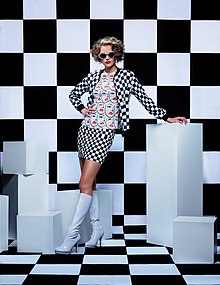
The spring of 2021 saw a revival of psychedelic mid-to-late 1960s fashion in the UK, Asia, the US, and Africa. Clothing such as miniskirts, slim fit capri pants, denim jumpsuits,[76] flared trousers,[77] patched jeans,[78] dog's tooth check skirts and mini-dresses, and cropped slim jeans[79] were popular pants among younger women.
Other favoured styles included prairie dresses with floral embroidery;[70] backless sundresses;[80] floor-length kaftans with jeans;[81] Pendleton jackets; hippie style mood rings popularized by Lorde; tiered flamenco dresses that flare out below the knee;[82] satin slip dresses; jumpers with smiley faces and mushroom designs; satin blouses; checkerboard sweater vests;[83] leather three-quarter length coats; Crombie style wool overcoats; leopard print winter coats;[84] zip collar turtleneck sweaters; zip-up polo shirts with white collar trim;[85] clothing with sunflower print; checkerboard motifs; and diamond and hexagonal prints. Popular colours during this time included brown,[77] sage green, royal blue, hot pink, orange, yellow, and purple.[86]
Comfortcore, cottagecore and coastal grandmother
The lockdowns of the COVID-19 pandemic led a whole generation of women worldwide to prefer homely and comfortable clothes to wear at home. From 2020-2022, many subtrends emerged from this so-called "comfortcore" movement.[87]

A nostalgia-driven subtrend was cottagecore (grandmacore, faeriecore, farmcore, goblincore) even though it goes beyond fashion to include all designs. The cottagecore subtrend was reinforced by Taylor Swift's 2020 albums Folklore and Evermore.[88] The cottagecore style was defined by pastel colours and palettes that evoked a romantic, idealized country aesthetic.[89] Typical clothing included prairie dresses, blue gingham mini-dresses, white gypsy tops with multicolour Mexican-inspired floral embroidery, and hippie-style maxi dresses inspired by those worn during the late 1960s. Gingham and austerity-era floral patterns dominated the aesthetic.[89] An urban derivative of cottagecore known as "allotment chic" became popular in the UK during the early to mid 2020s and featured oversized linen gilets, cotton twill maxi skirts, pinafore dresses, chunky knitted cardigan sweaters and earth tones like olive green, brown, sage green, marigold yellow, tangerine orange, and ecru.[90]
"Retirement-wear" was a subtrend where young Gen Z and millennial generation women in America adopted the comfy-looking style of their elders, and borrowed styles from nostalgia-filled figures such as Dianne Keaton.[87] The 2022 trend "coastal grandmother" brought a "beachy, romantic aesthetic" associated with the rural American East Coast.[91][92][93] It combined elements of cottage-core with spring and fall beachwear[94] especially white jeans, cashmere turtleneck sweaters, pastel pink flip-flops, woven tote bags made from recycled fabric, and straw beekeeper style sun hats.[95]
Mid 2020s (2023–present)
Dopamine dressing and oversized garments
Continuing on from the maximalist and 1980s influences of the early 2020s, vibrant coloured clothing had made a comeback for women in America, France, China, Korea, and Ukraine[96] by the spring of 2023.[97] This style, sometimes referred to as "dopamine dressing", featured long skirts and belted maxi dresses with thigh splits, lots of gold and pearl jewelry, neon blue tights,[98] oversized striped cardigan sweaters, multicoloured silk skirts with seashell or floral print, strappy sandals, pants with a contrasting stripe down the leg, ugg boots,[99] floral print maxi skirts, Y2K inspired platform shoes, chunky red rain boots,[100] shimmery jumpsuits,[101] knitted dresses, leather pilot jackets with faux fur collars,[102] skirts with bold contrasting vertical stripes, trouser suits with bootcut legs, jeans with glittery heart or star-shaped details, chunky white or black sandals, and zebra print tote bags.[103][104] A dressier, more summery variant of dopamine dressing, known as "Italian garden party core", incorporated Mediterranean-inspired elements of cottagecore, such as pink mary janes, white, green, baby blue or pink shirt dresses with fruit, leaf and floral patterns, straw hats, peach colored off the shoulder peplum dresses, and gladiator sandals.[105]
Big, oversized garments were often made from translucent materials and featured cutouts intended to expose the wearer's bare shoulder, thigh, or midriff, such as low-cut waists on the pants or tops with strappy necklines intended to be worn braless.[106] Desirable colours included neon green, watermelon green, coral pink, orange, salmon pink, magenta, gold, electric blue, aquamarine, cyan, turquoise, and royal blue.[107][108]
Glamour wear
In Britain and America, luxury fashions often with shiny or metallic detailing became popular evening wear and clubwear by the winter[109] of 2023. Desirable items included brown minidresses sometimes featuring bronze sequins,[110] metallic or sequined tuxedo jackets, bark colored silk midi dresses,[111] small leather handbags,[112] 1990s fashion inspired Mary Janes, pantywaist tops, goth fashion inspired black midi dresses,[113] Y2K inspired pointy court shoes, sheer belted mini dresses with green sequins,[114] metallic silver pants,[115] knitted dresses in grey, navy blue, cream or black sometimes featuring intricate Nordic inspired patterns,[116] rhinestone cowboy boots, white shawl lapel sportcoats, black or white embroidered western shirts or fringe jackets,[117] lots of silver jewelry, silver brocade slip dresses,[115] dresses decorated with feathers,[109] flared trousers[118] white dresses, Scandinavian inspired enamel jewelry,[119] timeless "quiet luxury" inspired mock turtleneck sweaters, black leather block heel knee high boots,[120] baguette bags in metallic black, silver, green, red, or brown,[121] satin blouses,[122] black tuxedo style trouser suits,[123] black polka dot dresses and satin half-slip skirts worn as outerwear,[124] and grey old money inspired Crombie style overcoats.[125] Desirable colors included silver, black, white, navy blue, dark green, sky blue, and bronze. Many younger women hired going-out outfits from websites like Net A Porter rather than buying fast fashion dresses and only wearing them once on a night out.[126]
Balletcore fashion
Ballerina-inspired fashion in the mid-2020s had a significant impact on the fashion industry, influencing both high fashion runways and mainstream street fashion.[127][128] This trend drew inspiration from the graceful and elegant aesthetic of ballet dancers, incorporating elements such as soft tulle fabrics, delicate lace, wraparound silhouettes, ballerina skirts, and ballet flats into clothing designs. The trend also emphasized a more feminine and romantic style, with pastel colors, flowy skirts, and off-the-shoulder tops becoming popular choices for fashion enthusiasts in Singapore, the UK and America. The influence of ballerina fashion extended beyond clothing, inspiring hairstyles such as soft buns and loose waves, as well as delicate accessories like ribbon chokers and ballet slipper-inspired shoes. Ballerina-inspired fashion brought a sense of whimsy and ethereal beauty to the fashion world during this period and also increased the popularity of ballet-inspired workout wear, with brands creating collections that combined functionality with a balletic aesthetic.[129][130][131]
Men's clothing
Early 2020s (2020–2022)
Late 1990s–2000s influences
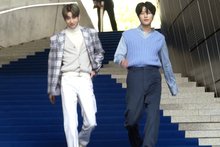
From 2020 onwards, many fashions of the late 1990s and early to mid-2000s returned in Europe and America. This included mixing selected contemporary fashion brands with original vintage clothing and recent thrift shop finds.
Popular trends in the UK, Italy, Sweden, China, the US, and Australia included black or white crew neck shirts, midnight blue U.S. Woodland camouflage baseball caps, straight leg jeans like the Levi Strauss 501 instead of the skinny jeans popular in the 2010s, bold multicolour motif shirts popularized by DJ Khaled, tracksuits with business suit styling, gorpcore ("Good ol' Raisins and Peanuts") hiking and fishing clothing like Fjallraven windbreakers and cargo pants, Sandqvist canvas rucksacks, jogger pants as athletic style, twill joggers as a dressed up style, black trench coats leather reefer jackets reminiscent of those worn in The Matrix,[132] imitation leather messenger bags featuring throwback logos, Fred Perry Oxford shirts with vertical stripes, and club wear — especially brightly patterned camp shirts.[133][134][135][136][137][138][139][140][excessive citations]
Other popular items include workwear like fleece jackets, zip-up hoodies, unbranded baseball caps, rubber pool sliders, flip-flops in contrasting shades like purple and white, corduroy pants, trucker caps, brightly coloured hoodies with bold designer logos like Polo Ralph Lauren, Champion Sportswear and Super Dry, and slim-fitting grey or khaki cargo pants worn with matching lightweight M65 Field Jackets with multiple external patch pockets.[141][142][143]
2000s fashion trends featured hip-hop-inspired track jackets, athletic tank tops, wide-leg jeans, turtleneck sweaters, Burberry motifs, neon socks, sports jerseys, cargo pants, bomber jackets, Madras plaid shirts, Henley shirts, blouson style leather jackets, long sleeve polo shirts, silk skinny ties, tapered high-waisted pants, brow line sunglasses, pleated khaki chino pants, mid-washed jeans, tie dye socks, oversized sweaters, and more. These trends were popular among Welsh soccer fans during the 2022 Fifa World Cup.[144][145][146][70][147][148][149][150][151][152][153][154][155][156][157][158][159][excessive citations]
Common footwear included classic Air Jordan sneakers, loafers with chunky brothel creeper soles favoured by Shawn Mendes,[160][161] suede desert boots, cyan floral print Vans sneakers popularized by Nick Jonas,[162] all-black imitation leather Adidas trainers,[163] suede Timberland boots, Gucci loafers,[164] Lacrosse or Sorel duck boots, suede Beatle boots[165] chunky hiking sandals, high top Converse All-Stars,[166] Nike Air Max sneakers,[167] worker boots, and combat boots bought as army surplus.
Desirable colours included white; orange; brown; black; yellow; greens, such as olive and lime; blues, such as indigo, sky, cyan, and navy; and tans, such as khaki and taupe.[136]
As a result of the increase in remote work, workplace dress codes became more casual. Employees returning to the office frequently combined the 1990s business casual attire with elements of loungewear and athleisure such as black monotone sneakers, navy hoodies, shorts, and even dark grey sweatpants.[168]
Due to gym closures, digital smart watches with timers replaced analog wristwatches as many younger men in Europe and America subscribed to online apps for tracking and planning their exercise routines at home.[169][170] In the UK,[171] Middle East, and some parts of Africa,[172] keffiyehs were used in an attempt to block viruses[173] and to show support for Palestinian nationalism.[174][175][176]
1980s revival

Due to many 2000s fashions being throwbacks to the late 1970s to early 1980s,[177][178] clothing such as pinstripes, textured knits with vertical stripes, leather waistcoats, corduroy clothing, navy blue and emerald green power suits with shoulder pads,[179] pleated trousers, and Chelsea boots regained popularity. Shirts with large and pointed collars became trendy again.[180] The increased formality for men returning to the office was, in part, a reaction to the ubiquitous casual wear associated with working from home during the coronavirus lockdowns of 2020–21.[181]
In Britain and the US, clothing that regained mainstream popularity included clothes with sports logos[182] and colour blocks, Harrington jackets, baseball jackets, stonewashed denim jackets,[183] and red or green plaid trucker-style jackets with sheepskin lining,[184][185] aviator sunglasses, brown shearling flight jackets,[186] plaid suits, striped full-button cardigan sweaters with polo shirt collars, white Converse All-Star or throwback Adidas sneakers,[187] tan gabardine trenchcoats reminiscent of those worn by 80s TV detective Columbo,[135] preppy style aran sweaters and fairisle cardigan sweaters with shawl collars,[188] safari suits intended for the modern business casual workplace, double-breasted 1940s-style blazers originally revived in the 1980s as the power suit, camp collar shirts with bold prints or stripes,[189] corduroy sports coats,[190][191] Ivy League college-style cardigans with trim,[192] jacquard, dog's tooth, and cashmere check wool scarves,[193] tricolour socks,[194] Vans,[195] monotone Plimsoll shoes,[137] towelling polo shirts,[191] turtlenecks, and t-shirts featuring vintage-inspired graphics such as muscle cars, comic book characters,[196] and brands such as Coca-Cola.
Colours such as green, grey, navy blue, red, black, white, forest green, and orange became popular in 2021. Other desired articles of clothing included stylized pale blue and magenta representations of palm trees or cassette players, and 1980s movie posters such as Star Wars or the Ghostbusters logo due to the unexpected popularity of the 2021 film.[197][198]
Workwear and street fashion

Since the late 1990s, functional workwear items like Dickies trousers and Barbour jackets have been fashion statements, first sold through independent menswear stores like American Classics in London and Oi Polloi in Manchester. Workwear was as common on the high street as it is in department stores, with many fast-fashion labels even offering capsule collections of blue-collar staples like chore jackets and selvage denim jeans.[199][200] Brands such as Carhartt, Dickies and Uniqlo saw success throughout the beginning of the 2020s thanks to their close association with hip-hop, streetwear, and skate culture. Crewneck T shirts especially in white or black, green or navy blue overshirts, dress socks, safety boots resembling sneakers, black or khaki Dickies 874 pants,[201] and folded knit caps became wardrobe essentials during this period.[202][203]
Gender neutral clothing
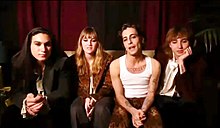
Genderless fashion is a global movement with ties with women's and LGBTQ liberation.[204] Originally a genderless fashion in Japan, it went mainstream in America, Korea[205] and the UK by 2021, with fashion experts speculating that the emerging androgynous style represents a new ideal of male beauty.[206] The style took inspiration from 1980s fashion, anime, trendsetters like Ryuchell, and the often androgynous style of K-pop boy bands.[207] Dyed hair, makeup, short shorts,[208] knee socks, necklaces, tight pants, brothel creepers, Pink Panther and Betty Boop motifs, feminine blouses in leopard print,[209][deprecated source] and silver or bright colours like pink and orange[132] were particularly common.
Men on the red carpet were also embracing accessories like feather boas[210] and pearl jewelry.[211][212] Other popular articles of clothing included kimono style shirts, frilly lace blouses, tunics,[132] boots with stacked Cuban heels, crop tops, furry ugg boots,[213] kilts,[214][213] mint green safari jackets with Nudie Cohn inspired embroidery,[215] shiny jackets with shoulder pads and puffy sleeves, flared trousers,[209][deprecated source] transparent shirts, shawl lapel sports coats[216] sometimes covered with sequins or rhinestones, oversized silk shirts in purple, green, gold or silver,[132] and suits in eccentric colours like gold lame,[132] shiny green sequins, or fuchsia.[217]
During the early 2020s, many young men in America favored shorter athletic shorts, sometimes referred to as "hoochie daddy shorts", with a 5-inch or even a 3-inch inseam.[218][219] Several factors contributed to the rise in popularity of 5-inch shorts, including the popularity of men's thighs on social media, a greater acceptance of gender-fluid clothing in mainstream fashion, and general comfort and fashion trends.[220][221][222][223]
Originally athletic wear, jock straps were worn as regular underwear by many gay men before 2020.[224][225] However, during the early 2020s some straight men have been buying them either as an erotic gag gift or as fetish wear for the bedroom.[226][citation needed]
The leading trendsetters in androgynous fashion during this time included Harry Styles,[227][204] Italian shock rock group Maneskin, actor Timothée Chalamet,[228] Bad Bunny, Lil Nas X, Billy Porter,[229] Brad Pitt,[230] Paul Mescal,[208] African entrepreneur Ezra Olubi,[231] and Jimin.[232] Due to the influence of artists like Ru Paul, Jodie Harsh and gay singer Sam Smith,[233] drag queen-inspired outfits went mainstream.[234] Influential designers included Harris Reed, JW Anderson, and Bode.
Mid 2020s (2023–present)
Vintage Americana and patriotic motifs
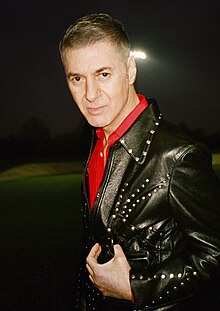
From 2023-24, the predominant colours in Britain, Australia, France and America were red, white[235] and blue.[236] As in the mid-to-late 1970s, Western shirts with pearl snaps in denim, black gabardine or bright madras plaid made a comeback, and sometimes featured contrasting yokes[237] and cuffs with intricate embroidery.[238][239] Moccasins, stonewash denim waistcoats with decorative fringes, preppy loafers, navy blue suits and sportcoats, Wrangler jeans[240] or Levi Strauss jeans,[241] suede fringe jackets popularized by Pharrell Williams, Noel Fielding, Post Malone and Beyonce in anticipation of the release of her Cowboy Carter album,[242] straight leg jeans instead of the skinny jeans fashionable from the late 2000s until the mid-2010s,[243] stetsons, white baseball jerseys with bold red or blue pinstripes, striped blue neckties, baggy white pants, Union Jack motifs, Panhandle Slim, Rockmount and Scully sportcoats with contrasting Western-inspired yokes and embroidery,[244] flared jeans, duster coats as worn in the Yellowstone TV series,[245] preppy style college sweaters, retro blue and white striped football shirts,[246] chelsea boots with cowboy boot styling, two-button blazers with red and blue boating stripes, V-neck sweater vests, royal blue baseball jackets with white sleeves, Howler Brothers gilets,[247] shirts and suits worn open to expose the chest,[248] and boxy leather reefer jackets were popular on both sides of the Atlantic.[249][250]
Eclectic grandpa
The "grandpa core" fashion trend of 2024, also known as "eclectic grandpa", is characterized by vintage-inspired casual fashion from the late 1940s to early 1960s. It draws inspiration from the fashion sensibilities of grandfathers from the silent generation and incorporates colorful knitwear like patterned sweater vests or shawl collar cardigan sweaters, braces, loafer shoes, corduroy, high waisted dress pants, and various tweed accessories especially flat caps. Celebrities such as Harry Styles, Kendall Jenner, Gigi Hadid and Tyler, the Creator have played a significant role in popularizing this trend among the mainstream fashion public in the UK and America.[251][252][253][254]
Youth fashion
E-kids, emo and alternativeedit
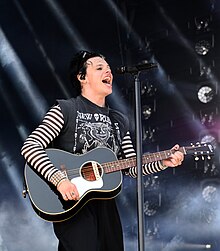
In 2020, internet and social media access re-popularized 1990s and 2000s subcultures and fashion trends, including the alternative fashion popular among scene kids, punks, emos, skaters, Hyperpop and shoegaze fans,[255] and mall goths.[256][257][258]
Self-proclaimed "alt" Gen Z youths, including many e-kids, aimed to replicate the late 2000s emo culture, leading to a revival of secondhand stores and fashion. Emo fashion features dark colors, especially black, with common items including plain black or graphic printed hoodies, skinny jeans, sneakers, and intricate details like studded belts and skull jewelry. During the early and mid 2020s, e-kids and emo revivalists often incorporated punk and skater inspired accessories like checkerboard Vans or all-black Converse All-Stars. They showcased unique styles on YouTube and TikTok, driven by nostalgia and the belief in liberated fashion. The pop punk revival of the early 2020s was associated with acts like Machine Gun Kelly, Olivia Rodrigo and Yungblud, as well as 2000s groups like Paramore releasing comeback albums.[259][260][261][262][263][264][265][266]
Crossover subgenres like Y2K Post-Grunge also gained prominence thanks to apps such as Pinterest and Tik Tok. Wardrobe staples being Affliction shirts, Tripp pants, wolf cut, DC Shoes, baggy cargo pants, Harley Davidson and Ed Hardy accessories.[267][268][269][270]
E-kid culture of the late 2010s and early 2020s was influenced by anime, emo rap and hyperpop. Celebrities such as Belle Delphine, Corpse Husband, Dua Lipa, Billie Eilish, Yungblud,[271] Lil Peep, Bladee, and Juice WRLD were viewed as style icons[272] The mall goth subculture of the late 1990s, with its nu metal and industrial metal influences, also provided some inspiration for teenage e-girls, as did horror-themed Netflix series such as Wednesday Addams and the Chilling Adventures of Sabrina. Striped long sleeve T-shirts, Hot Topic branded clothing, gothic makeup, BDSM accessories, tennis skirts, dyed hair, and thigh highs are wardrobe essential for the e-girl look. At the same time, the term e-girl also came to bear a negative connotation due to its connection to sex work and cultural appropriation, leading to the term's decline in cultural popularity.[273][274][275][276][277][278]
Hip hop, vamp and Opiumedit


For Black American and Black British youth, hip hop fashion became more politicized. This was due to the influence of social justice rappers including Stormzy,[279] No Name,[280] the Black Lives Matter movement, and a resurgence of interest in past civil rights organizations such as the Black Panther Party.[281] Slogan T-shirts inspired by punk fashion,[282] black leather jackets or trench coats,[283] hoodies,[284] black sweatpants, face-concealing black bandanas, dark glasses, marijuana motifs, skull masks, morale patches, paramilitary tactical vests,[281] and camouflage patterns were popular. Black American activists in the American south sometimes wore blue union army kepis at the demolition of Confederate statues to taunt lost cause revisionists and white supremacists.
American record label Opium, founded by musicians including Playboi Carti, Ken Carson and Destroy Lonely was another source of inspiration for streetwear trends in the 2020s. Designer clothing, leather, and BDSM-inspired accessories made up the Opium aesthetic. This Goth-inspired hip-hop trend includes designer jewelry, dyed dread locs or braids, and layered monochromatic outfits.[285][286][287][288][289]
VSCO girls and preppyedit

VSCO girl is a clothing style that tried to emulate the style of the photo app, VSCO. These girls wear scrunchies on their wrists and in their hair with high-side ponytails and headbands. Footwear includes white sneakers, ballet flats, and sandals. They wear either no makeup or little makeup that blends with their skin and prioritizes a cute and comfortable style.[290] Popular e-girl options include high-waisted pants, oversized tie dye T-shirts, long sweatshirts or sweater dresses, bike shorts, Nike track shorts, Nike Tempo shorts, capri and ankle length leggings with socks,[291] T-shirt dresses, denim skirts, overalls, shortalls, high-waisted mom jeans, shirts, sweaters, sweatshirts tucked in their jeans and a belt, headbands, and Nike Elite socks in many different colours. Due to the extensive mockery and overexposure this subculture endured on TikTok, the term VSCO girl became quickily phased out of popular culture despite the clothing's continued popularity throughout the decade.[292][293][294][295][296][297]
Although the term "preppy" has very little in connection with its original definition, Gen Z and Gen Alpha used it to describe a look similar to VSCO.[298][299][300] Stanley cups, Drunk Elephant skincare products, Lulu Lemon and Zara clothes are essentials for achieving this look. Brands such as Brandy Melville, Nike and H&M were also popular.[301][302][303][304]
Soft grunge and kidcoreedit
In the early 2020s, American indie kids adopted a youthful aesthetic, taking cues from Japanese kid-core subculture, indie pop, energy drinks, indie rock, and skater fashion.[305] Self-proclaimed indie teenagers disapproved of fast fashion and sought vintage items, leading American and European teens to frequent thrift stores like Goodwill for trendy items such as wide-legged jeans, oversized zip-up hoodies, striped cardigans, crop tops, collared shirts, shoestring belts, mom jeans and other high-rise pants, shortalls, bucket hats, Doc Martens,[306] platform shoes, shredded denim, flower crowns, and tennis skirts.[307][308][309] Individuals who influenced this trend include indie rapper Russ and Australian rapper the Kid Laroi.[310][311] Critics criticized the anti-conformist and environmentally friendly trend, which involved reselling cheap second-hand clothing at inflated prices.[312][313]
Indie sleazeedit

In contrast to the brightly coloured, childlike outfits popular in America, and the mismatched clothing previously worn ironically by hipsters during the 2010s, British indie pop fans favored a darker, more authentic post-punk and garage rock-inspired aesthetic. Critics have compared the early 2020s indie rock revival, with its 1960s- and Noughties-inspired outfits, to the original British Invasion.[314]
Members of the UK indie subculture combined thrifted dress clothing[315] from the mid-2000s to early 2010s with selected vintage clothing and new garments made to retro 1960s patterns[316] by companies such as Madcap England.[317] Artists including Sam Fender, Wet Leg, Lathums, Years & Years, and Wolf Alice popularized velvet or paisley tuxedo jackets in dark blue, green or burgundy, off the peg dark wash slim fit jeans, striped polo shirts with cardigan sweater styling,[317] white T shirts, black leather jackets,[318] bucket hats, plaid or black miniskirts, dresses with red or black polka dots, striped throwback football shirts popularized by Sam Fender,[319] blouses especially in orange or brown, Argyle golfing sweaters,[318] black or grey Prince of Wales check sport-coats, checked western shirts, ripped jeans, red Doc Martens, suede Beatle boots with pointed toes, bowling shoes, brothel creepers, and parkas.[320][321][322]
Old money, dark and light academiaedit
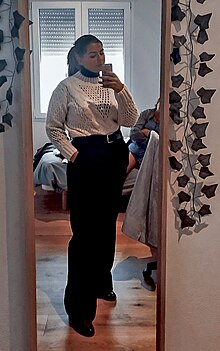
The dark academia aesthetic, which combined elements of preppy fashion and gothic fashion, was heavily influenced by 1930s and 1940s fashion, particularly attire worn by students at Oxbridge, Ivy League colleges, and prep schools during the time.
Cardigans, oxford blue rowing blazers with contrasting white trim,[323] dress shirts, plaid skirts, tights, knee socks, Oxford shoes, ballet flats, white sneakers, twill jogger pants, and apparel made of houndstooth, and dark grey or brown tweed sportcoats are some of the most identified articles of clothing with the dark academia aka old money aesthetic. The typical colour palette consisted primarily of black, white, beige, browns, dark green, and occasional navy.[324][325] The style has been criticized for its having themes of Eurocentrism, classism and unhealthy learning practices.[326][327]
A closely related style, known as "light academia", was characterized by neutral and light colours, including soft blues, pinks, whites, creamy yellows, beige, light greys, light purple, pastel and dusty colours, plaid, stripes, and argyle patterns reminiscent of the preppy look of the early 1980s. Variants to this style, which originated in America as an internet trend, included "pastel academia," "romantic academia," and "chaotic academia".[328]
Goblincore, fairy grunge, coquetteedit
This article may contain an excessive number of citations. The details given are: Too many citations and no attribution for subjective statements, specifically in 3rd paragraph regarding Coquette aesthetic. (January 2024) |
Goblincore, also known as gremlincore, is an American subculture and style of art based on the enjoyment of features of nature that are not conventionally considered beautiful. The goblin is an evil thieving creature in European mythology, but it also serves as a carefree expression of infatuation with nature's ugliness. Animals like frogs, snails, and materials like moss, dirt, plants, and fungi like mushrooms are associated with goblin core.

Goblincore was popular in the LGBTQ+ community. Attire could include[329] adventure-ready gear, ensembles with multiple clashing patterns/colours, oversized sweaters, and worn-out or customized pants and overalls. Much of the apparel is worn-out, thrifted, or second-hand for a relaxed vibe, similar to the look of crust punks in the late 1990s. As many goblincore enthusiasts were comfortable with getting dirty, keeping their clothes clean was not a priority.[330]

Fairy grunge combined the aesthetics of fairycore, coquette, and grunge. Social media creators were mostly responsible for popularizing this aesthetic. Fairy grunge can be seen as a natural extension of the kinderwhore style — which has deep roots in grunge — but with a more ethereal note. Fairy grunge often included oversized t-shirts or hoodies, long or mini skirts, nightgowns, corsets, mittens, gloves, skull patterns, mesh tights or fishnets, high knee socks, leg warmers, platform Demonia shoes, fairy wings, and elf ears.[331][332]
Nymphet, also known as coquette, is an aesthetic that draws on a character cliché first used by Vladimir Nabokov in his 1955 novel Lolita and its two subsequent film adaptations (1962 and 1997). Heart-shaped sunglasses, pastel colors, floral/cherry patterns, ballet shoes, hair bows, pigtails and lace dresses are essential to achieving the coquette look. Musician Lana Del Ray is cited to be a style icon and helped popularize the nymphet aesthetic for Gen Z women.[333] Coquette has been criticized by some writers, such as Iustina Roman, for the glamorization of eating disorders, pedophilia, racism, and classism.[334] Some writers[attribution needed] have made the argument that coquette could be viewed as a feminist way for women reclaim girlhood and innocence.[335][336][337][338][excessive citations]
Barbiecore, McBling, and gyaruedit

Bimbocore, also known as Barbiecore, is an American and Canadian feminist fashion subculture that reclaims the sexist stereotypes of American starlets from the 2000s. Bleached blonde hair, Juicy Couture. Von Dutch, Ed Hardy, skimpy skintight clothing, and McBling-inspired fashion accessories characterize Bimbocore. A visually similar Japanese subculture, known as Gyaru, dates back to the late 1990s. The style acts as a meta-ironic parody of the mid-2000s to early 2010s millennial girlboss feminism, acknowledging that they are appealing to heteronormative feminine beauty standards and sexist stereotypes, while being trans inclusive and sex positive.[339] Pro-sex work and pro-women's rights, Bimbocore gained popularity in leftist TikTok communities.[340][341][342] McBling, a similar aesthetic, was commonly mislabeled as Y2K. Millennial pink as worn by Margot Robbie in the Barbie film,[343] rhinestones, small handbags, large sunglasses, and pop music define this aesthetic.[344][345][346]
Bimbocore was criticized for glamorizing the sugar baby lifestyle, bimbo feminism[347] and adult platforms such as OnlyFans, but that did not end the movement's popularity with Gen Z.[348][349][350] McBling has also been thoroughly criticized for racism, whitewashing, classism, and fatphobia.[351][352][353]
Gorpcoreedit
Gorpcore is a style that emerged in the late 2010s and early 2020s, coined by Jason Chef in 2017. Gorpcore incorporates tech-based, loose-fitting outdoors and camping-chic inspired styles. A significant part of this style category is defined by the earthy and muted tones often found in the range of gear included in the trend, such as olive green, khaki, beige grey marl, and horizon blue. The style reuses and incorporates style inspirations from previous style generations and similar outdoorsy styles. The style is somewhat open for interpretation because it is fairly new, making it flexible and creative, although certain patterns and forms often help classify an outfit as gorp.[354]
Brands associated with the gorpcore aesthetic include Arc'teryx, Patagonia, The North Face, and more. The trend is considered by many to be elitist, and often the brands associated are premium brands with high price tags out of range for average wage. Apparel pieces that make up the trend include down jackets, body warmers, anoraks,[355] utilitarian Eagle Creek and Osprey rucksacks, crew neck and v-neck t-shirts with zip pockets,[356] utility pants, moisture-wicking trekking shirts with short sleeves and snap fasteners,[355] knit caps, big headphones and racer-glasses.
The fashion style attempts to align with the desire for sustainable fashion, and often relevant clothing element pieces can be found in vintage, second-hand, or thrift shops. Additionally, designer pieces that fit the mode can be found in e-commerce stores like Depop or Thred-up.
The style is unisex, reflecting how people search for new ways to incorporate previously underutilized categories of utilitarian outdoor activity-related clothing into modern urban settings.[357][358][359][360]
Hairstylesedit
Women's hairstylesedit

Due to the restrictions on hair salons during the lockdowns,[361] many women grew out their hair or watched tutorials to do their own hair.[362] Popular styles included curtain bangs,[363] 1980s, 1990s and early 2000s-inspired bangs, hair extensions, ponytails, twin pigtails, French braid, shaggy hair commonly known as the "wolf cut",[364] and natural hair for Black American women.[365] Along with these hairstyles, 1960s-inspired beehive hairdos[366] were popularized by British pop singers Emily Capell and Joy Crookes[367] Early 2000s fashion-inspired straightened and brightly dyed hair was made popular by Doja Cat and Billie Eilish from 2021 to 2022.[275]
Common hair accessories included pearl and sequin hair clips, headbands, bandannas and scrunchies. During the lockdowns of 2020–21, some women in the UK, America, and Asia experimented with DIY hairstyles at home, including the bob cut, the crop,[368] the partially shaved head, bangs, and the pixie cut.[369]
From 2023 onwards, a longer straightened version of the bob cut, sometimes dyed blonde, became popular among middle-class women in Britain and America.[370] In 2024, ultra long hairstyles made a comeback. [371]
Men's hairstylesedit

By 2020, full beards associated with hipster subculture declined in popularity,[372] except in parts of the Middle East, Africa, Eastern Europe, and Latin America. When worn, beards in the West have generally trimmed short[373] to accentuate the wearer's features and facilitate masking.[374]
Hairstyles of the late 1980s, 1990s and early-to-mid-2000s such as side parted or centrally parted curtained hair,[375] permed hair, bleached hair, the "wet mop",[376][377]" mullets (especially in America and Australia),[378] quiffs, the "Edgar cut",[379] and shaggy hair[380] came back among teenagers and young adult men due to barbershop closures in the UK and US as a result of the COVID-19 pandemic.[381] Many younger Black American men opted for natural hair from 2021 onwards, especially the skin fade,[382] textured Caesar cut[372] and short versions of the afro or dreadlocks combined with an undercut. Meanwhile, many balding men in the UK, America, and Ireland continued to get buzz cuts at home during the lockdown.[383] Young males began growing mustaches in the summer of 2022, partially inspired by Miles Teller's role in Top Gun: Maverick.[384][385][386]
Cosmetics trendsedit
Skincareedit
Common skincare techniques in America during the early 2020s included "slugging" the face and hair with petroleum jelly.[387][388][389][390] Many Indian, European, Australian and American women and men also used sunscreen along with vitamin C and retinol serums in the form of a liquid, cream or gel[391][392] to reduce fine lines, protect against sun damage, improve collagen production, reduce blemishes, and address pigmentation issues.[393][388][394][395]
In April 2021, influencers on TikTok popularized gua sha, a Chinese skincare technique that uses face stones to promote blood and energy flow. Another Asian technique, using rice water as a hair treatment, simultaneously gained popularity in the West.[396] Baby botox was sometimes injected into the foreheads of young women to prevent wrinkles as a preventative treatment.[397]
Makeupedit
The clean girl look evolved from the previous decade's model off duty aesthetic. The term was coined during the early 2020s to characterize the makeup style pioneered by American models like Bella Hadid and Lily Rose Depp. This casual monochromatic tone style had matching clothing sets that complemented the cosmetics, button-down shirts, slicked-back hair, fluffy brows, dewy skin, flushed cheeks, and glossy lips.[398][399] The style was focused on appearing effortlessly flawless and casual, adapting all the fashion trends from the early 2020s and giving them a muted tonal colour palette and a sexy, carefree attitude.[400] The strong emphasis on skincare, diet, and exercise made the clean girl not only a fashion statement but a lifestyle as well, similar to her 1960s predecessor. The aesthetic has been criticized for cultural appropriation, toxic positivity, and fatphobia, which affected its mainstream popularity.[401][402]
The maximalist graphic eyeliner trend of 2022 allowed British and American women to emphasize their eyes with vibrant colours and geometric designs. Graphic eyeliner made headlines and introduced women to new methods to experiment with facial makeup.[403][404][393]
Tattoosedit
From 2021 onwards, new tattoo styles emerged among younger trendsetters. Popular trends included colourful modern reinterpretations of traditional Japanese tattoos, psychedelic art, tramp stamps, minimalist black and white portraits, lightning bolts, fine art, pop culture mashups, holograms, and dot work.[405] Other popular tattoo designs included spiritual meanings such as representations of the Buddha, Hindu mandalas, and the tree of life.[406] Tribal tattoos and hyperrealistic portraits of loved ones popular during the 2010s declined.[407]
Plastic surgeryedit
The Brazilian butt lift is a gluteal fat grafting procedure that utilizes excess fat collected from other body areas to add buttock volume and projection or adjust overall shape and symmetry. The Brazilian butt lift reached its peak media coverage in 2021,[citation needed] when it was declared to be "the world's most dangerous cosmetic surgery",[408][409] with news headlines discussing the procedure's risks and fatalities following the procedure.[410][411][412][413]
The "fox eye lift" in particular, was a contentious cosmetic trend because of the strong racial connotations associated with giving someone an oriental eye shape.[414][415] The concept of a positive canthal tilt became a topic of discussion for men and women, due to social media platforms such as TikTok.[416][417][418]
Exhibitionsedit
2020edit
- "About Time: Fashion and Duration" October 26 until February 7, 2021, at the Costume Institute at the Metropolitan Museum of Art in New York City.[419]
2021edit
- In America: A Lexicon of Fashion at the Costume Institute at the Metropolitan Museum of Art in New York City
2022edit
- "Fashioning Masculinities: The Art of Menswear" March 19 until November 6, 2022, at Victoria and Albert Museum in London[420]
- "Africa Fashion" July 2 - April 16, 2023 at Victoria and Albert Museum in London[421]
2023edit
- "DIVA" June 2023 - April 2024 at Victoria and Albert Museum in London[422]
Galleryedit
-
Singer Jack White wearing striped Madcap England blazer, 2021.
-
Teen girl wearing early 2020s fashion trends.
-
2021: Nikki Phillips in Fashion Week.
-
Student in 2022.
-
Woman attending 2022 Fashion Week.
-
Clothes for sale in 2021.
-
Actress Dove Cameron sporting early 2020s makeup trends.
-
The mullet/shaggy hairstyle became a popular hairstyle among men.
-
Indonesian girls wearing face masks in 2022.
-
2020: Blush pink dress designed by Shey Natividad for DC Fashion Week.
-
Stand-up comedian Kurtis Conner wearing early 2020s mullet hairstyle and mustache.
-
Actor Finn Wolfhard wearing early 2020s Indie Fashion
-
Elderly man dressed up in Stockholm in 2023
-
Icelandic pop artist Laufey dressed in a high-collared tank top and jeans.
-
Contemporary Chinese Mao jacket, 2023.
See alsoedit
- 2020s
- Impact of the COVID-19 pandemic on the fashion industry
- History of Western fashion
- Fashion design
- Deconstruction (fashion)
Referencesedit
- ^ "Now-stalgia: why fashion is going back to the future | Fashion | The Guardian". amp.theguardian.com. Retrieved 2023-03-24.
- ^ Malivindi, Diandra, ed. (27 May 2020). "9 Trends From The 2000s That Are Surprisingly Back In Style". InStyle. Archived from the original on 26 September 2020. Retrieved 25 September 2020.
- ^ "Gen Z Is Bringing the 2000s Back…Here's How Brands Can Keep Up". YPulse. 18 February 2020. Archived from the original on 26 September 2020. Retrieved 25 September 2020.
- ^ Shenoy, Seline (23 September 2021). "The '80s are back: 10 '80s fashion trends that are cool again". FOX31 Denver. Retrieved 2022-12-02.
- ^ "These 11 Fashion Trends Are Going Viral This Summer — But They're Actually From the '70s". InStyle. Retrieved 2022-12-02. Zdroj:https://en.wikipedia.org?pojem=2020s_in_fashion
Text je dostupný za podmienok Creative Commons Attribution/Share-Alike License 3.0 Unported; prípadne za ďalších podmienok. Podrobnejšie informácie nájdete na stránke Podmienky použitia.
Antropológia
Aplikované vedy
Bibliometria
Dejiny vedy
Encyklopédie
Filozofia vedy
Forenzné vedy
Humanitné vedy
Knižničná veda
Kryogenika
Kryptológia
Kulturológia
Literárna veda
Medzidisciplinárne oblasti
Metódy kvantitatívnej analýzy
Metavedy
Metodika
Text je dostupný za podmienok Creative
Commons Attribution/Share-Alike License 3.0 Unported; prípadne za ďalších
podmienok.
Podrobnejšie informácie nájdete na stránke Podmienky
použitia.
www.astronomia.sk | www.biologia.sk | www.botanika.sk | www.dejiny.sk | www.economy.sk | www.elektrotechnika.sk | www.estetika.sk | www.farmakologia.sk | www.filozofia.sk | Fyzika | www.futurologia.sk | www.genetika.sk | www.chemia.sk | www.lingvistika.sk | www.politologia.sk | www.psychologia.sk | www.sexuologia.sk | www.sociologia.sk | www.veda.sk I www.zoologia.sk

